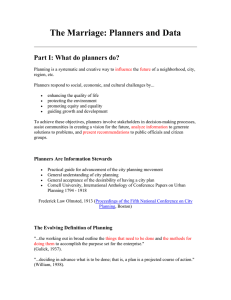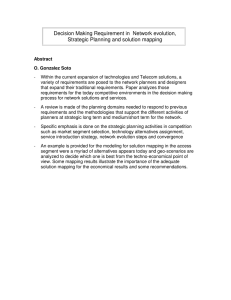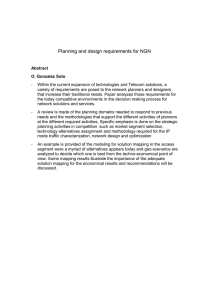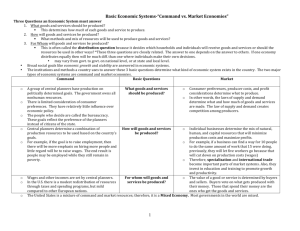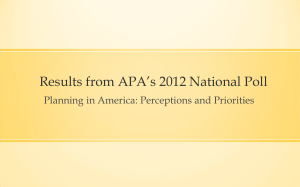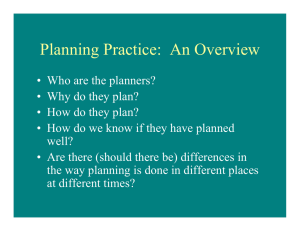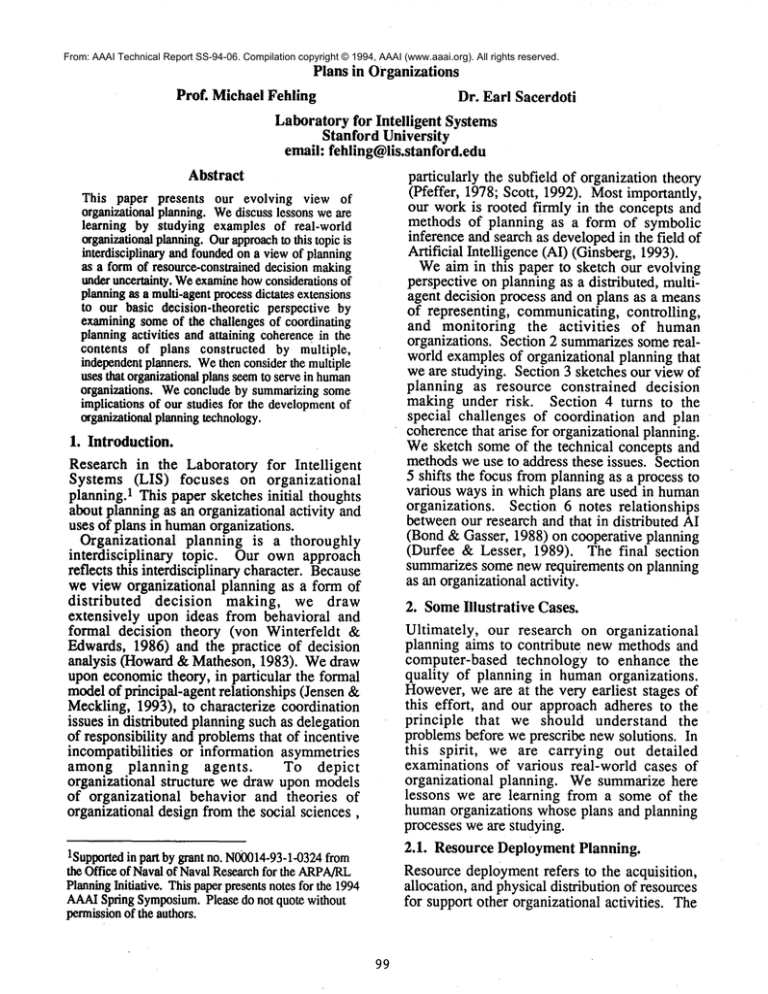
From: AAAI Technical Report SS-94-06. Compilation copyright © 1994, AAAI (www.aaai.org). All rights reserved.
Plans in Organizations
Prof. Michael Fehling
Dr. Earl Sacerdoti
Laboratoryfor Intelligent Systems
Stanford University
email: fehling@lis.stanford.edu
Abstract
This paper presents our evolving view of
organizational
planning.Wediscusslessonsweare
learning by studying examplesof real-world
organizational
planning.
Ourapproach
to this topicis
interdisciplinary
andfounded
ona viewof planning
as a formof resource-constrained
decisionmaking
underuncertainty.
Weexamine
howconsiderations
of
planning
as a multi-agent
processdictatesextensions
to our basic decision-theoreticperspectiveby
examining
someof the challengesof coordinating
planning
activities andattainingcoherence
in the
contents of plans constructed by multiple,
independent
planners.Wethenconsiderthe multiple
usesthatorganizational
plansseemto servein human
organizations.Weconcludeby summarizing
some
implications
of ourstudiesfor the development
of
organizational
planning
technology.
particularly the subfield of organization theory
(Pfeffer, 1978; Scott, 1992). Mostimportantly,
our work is rooted firmly in the concepts and
methods of planning as a form of symbolic
inference and search as developedin the field of
Artificial Intelligence (AI) (Ginsberg, 1993).
Weaim in this paper to sketch our evolving
perspective on planning as a distributed, multiagent decision process and on plans as a means
of representing, communicating, controlling,
and monitoring the activities
of human
organizations. Section 2 summarizessomerealworld examples of organizational planning that
we are studying. Section 3 sketches our view of
planning as resource constrained decision
making under risk. Section 4 turns to the
special challenges of coordination and plan
coherencethat arise for organizational planning.
Wesketch some of the technical concepts and
methodswe use to address these issues. Section
5 shifts the focus from planning as a process to
various ways in which plans are used in human
organizations. Section 6 notes relationships
betweenour research and that in distributed AI
(Bond & Gasser, 1988) on cooperative planning
(Durfee & Lesser, 1989). The final section
summarizes some new requirements on planning
as an organizationalactivity.
1. Introduction.
Research in the Laboratory for Intelligent
Systems (LIS) focuses on organizational
planning.1 This paper sketches initial thoughts
about planning as an organizational activity and
uses of plans in humanorganizations.
Organizational planning is a thoroughly
interdisciplinary
topic. Our own approach
reflects this interdisciplinary character. Because
we view organizational planning as a form of
distributed
decision
making, we draw
extensively upon ideas from behavioral and
formal decision theory (yon Winterfeldt
Edwards, 1986) and the practice of decision
analysis (Howard& Matheson, 1983). Wedraw
upon economictheory, in particular the formal
modelof principal-agent relationships (Jensen
Meckling, 1993), to characterize coordination
issues in distributed planning such as delegation
of responsibility and problemsthat of incentive
incompatibilities or information asymmetries
among planning
agents.
To depict
organizational structure we draw upon models
of organizational behavior and theories of
organizational design from the social sciences,
1Supported
in part by grant no. N00014-93-1-0324
from
the Officeof Navalof NavalResearchfor the ARPA/RL
Planning
Initiative. Thispaperpresentsnotesfor the 1994
AAAI
SpringSymposium.
Pleasedo not quotewithout
permission
of theauthors.
99
2. SomeIllustrative Cases.
Ultimately, our research on organizational
planning aims to contribute new methods and
computer-based technology to enhance the
quality of planning in humanorganizations.
However,we are at the very earliest stages of
this effort, and our approach adheres to the
principle that we should understand the
problems before we prescribe newsolutions. In
this spirit,
we are carrying out detailed
examinations of various real-world cases of
organizational planning. Wesummarize here
lessons we are learning from a some of the
humanorganizations whose plans and planning
processes we are studying.
2.1. Resource Deployment Planning.
Resource deploymentrefers to the acquisition,
allocation, and physical distribution of resources
for support other organizational activities. The
resource deployment activities which we are
studying include military crisis-action planning
(Fehling et al, 1993b)and supply-chain planning
for commercialmanufacturing processes.
In military crisis-action planning we focus on
synthesis and use of plans for logistics supply
and transportation schedulingto support military
operations. These operations might involve
armed conflict as in recent Desert Storm
operations in response to Iraq’s invasion of
Kuwait. Alternatively, crisis action plans may
be required to specify non-combat operations
such as U.S. relief efforts in Somalia or
domestic disaster-relief operations of sufficient
scale that support from military units might be
required (e.g., the federal response to hurricane
Andrew). We summarize some conclusions
about challenges of crisis action planning
presented in Fehlinget al. (1993a):
¯ Coordination: Participants
include a
complex hierarchy from the President
through
commanders
and their
subordinates in various theater-level
operations involving multiple services.
¯ Conflicting
Objectives:
Resourcedeployment units and their planners may
also be involved in other operations that
competefor attention.
¯ Uncertainty: Timely, full information is
resource whose scarcity may hamper
planners’ abilities to properly frame
objectives and accurately assess and
predict situational parameters.
¯ Constrained Deliberation: Time available
to plan often bars completion of thorough
analysis and planning tasks before
initiating a response.
This list does not exhaust the challenges posed
by crisis-action planning problems. It does
illustrate key difficulties posedby this and many
other forms of organizational planning. Crisisaction planners must rapidly solve a complex
problem under uncertainty. Their efforts are
thwarted by the added problems of cooperation
in a complex organizational
hierarchy.
Currently, these planners often rely on
previously constructed plans modified to fit the
current situation.
However, reused plans
seldomprovide substantive guidance beyond the
first steps of their use. Finally, cases wehave
studied suggest that the most profound
challenge is properly disseminating sufficient
information throughout the hierarchy to identify
suitable, clear objectives so that a plausible preconstructed plan can be chosen and used.
ioo
Supply chain planning is a commercialversion
of resource-deployment
planning.
A
manufacturing supply chain refers to all
activities that directly involvedin acquisition of
raw materials, transformation of these materials
into finished goods, and distribution of the
goodsto customeror client sites (Fehling et al.,
1993b). External suppliers and distributors may
be part of the supply chain as well as an
organization’s internal manufacturing and
distribution units. Weare studying supply chain
activities in U.S. manufacturingorganizations.
Our studies suggest that challenges to military
planning also hold for supply chain planning. A
complex organizational
structure must be
coordinated. Since resource deployment units
must support multiple operations, conflicting
objectives must be resolved. Uncertain and
incomplete information is also a major problem.
In one high-technology manufacturer we have
studied this problem is exacerbated by
uncoordinated use of multiple analyses yielding
conflicting conclusions on which supply-chain
planning decisions depend. Constraints due to
deadlines pose nearly as potent a set of
challenges as for military planning, although the
consequencesof reduced profit are not as severe
as the loss of life that can result from lack of
timeliness in military planning. Perhaps the
biggest difference betweenthese cases is in the
ability of supply chain planners to adapt and
reuse old plans. This is largely due to stability
of an organization’s supply chain architecture.
But, if supply-chain plans are needed for
operations involving new suppliers, products,
production processes, or distributors, then the
need to plan for new objectives become as
challenging as in the military planningcase.
2.2. Project Planning.
Now we summarize two examples of project
planning that we have been investigating.
The first example, urban planning, is typically
carried
out by municipal or regional
governmental units. The scope of planning can
range from creation of a single facility to
development of multiple facilities
and
infrastructure
for a large region. Urban
planningusually requires political action to gain
support for chosen plan. In early planning
phases, strategic objectives maybe even less
clear that in the case of military planning. This
maybe due, in part, to failure at an early stage
to have achieved consensus amongthe various
groups who have a stake in the planning
process. Perhaps for this reason, this type of
planning
is oftenfarmoredeliberate,
taking
manyyears
andinvolving
detailed
synthesis
and
evaluation
of manyalternate
plans
before
finally
producing
a politically
acceptable
version.
Initial
plans
serve
primarily
as "trial
balloons"
toelicit
responses
fromvarious
interest
groups
andhelpplanners
findfeasible
objectives.
The
interestgroupssee themselves
as active
participants
rather
thanpassive
evaluators.
Thus,
problems
duetoconflicting
objectives
are
often
quite
severe
inurban
planning.
We havealsostudiedplanningfor civil
engineering
construction
projects.
Forprojects
involving
construction
of multiplepublic
facilities
or private
facilities
withsignificant
public
impact,
thesecasesarcsimilar
to urban
planning.However,we have focusedour
attention
on casesof morelimited
planning.
In
thesecases,agentsmustdevisea planand
schedule
together
witha bidfora price
thatwill
wina contract
to do theworkas planned.
Upon
winningthe contracta detailedplanand
schedule
mustbe provided
to ensurethatthe
projectis completedon time and for the
contracted
price.
Thistypeof organizational
planning
shares
manyof thechallenges
posed
by the resource-deployment
casesabove.In
particular,
critical
deadlines
andcoordination
uncertainties
can posenearlyinsurmountable
difficulties.
For example,
the failure
of a
supplierto providecertainconstruction
materials
on timecan forceextensive
plan
revisiondue to dependency
of one planned
activity
uponcompletion
of another.
By studying
actualcasesof organizational
planning
wearegetting
a clearer
under
standing
of difficulties
thatmustbe overcome.
These
casestudies
alsoillustrate
of someoftheways
thatorganizations
exploit
plansbeyond
their
implementation.
Use of plansto clarify
organizational
objectives,
as notedabove,
is a
particularly
interesting
example
ofthese
broader
uses,
anissue
towhich
wcreturn
insection
5.
3. Planning
as Constrained
Decision
Making.
Wc viewplanningas a formof constrained
decisionmaking.The plansof real-world
organizations
and theirhumanagentsmust
address the risks imposedby planners’ uncertain
knowledge and the complex, potentially
conflicting values that underwrite planning
choices. These risks impact problem solving
directed toward managingany or all phases of a
plan’s life cycle, fromits synthesis, throughits
monitoring and execution, and including
replanning to adapt the plan to newinformation.
101
Planners’ abilities to deal with these hazards are
exacerbated by situational
constrains on
problem solving effort. This view of planning
frames our approach to organizational planning.
Wenowdiscuss a few of its implications.
3.1. Value-Based Choice under Uncertainty.
Planning as decision making under risk is a
newly articulated view in the AI literature.
Conventional AI planning models either assume
certainty or represent uncertainty in terms of
defeasible beliefs with provision for plan
revision if critical beliefs are defeated. Utility
considerations have been even more thoroughly
ignored. Conventional models of planning
presumesomea priori stipulation of a fixed set
of superordinate
objectives--goals--and
presumethat further inferences about objectives
are limited to finding subgoals that are
2consistent with the superordinate goals.
Recent planning research explores methods
adopted from formal decision theory for
probabilistic representation of uncertain belief,
explicit representation of subjective value and
utility,
and inference as maximization of
expected utility.
Dean and Wellman’s recent
text (1991) reviews this work. Researchers are
developingfully probabilistic methodsfor belief
representation and inference with algorithms to
calculate properties of so-called belief nets
(Pearl, 1988). Rather less attention and been
paid to representing and reasoning about values
and utility in planning. For example, little
progress has yet been made on reasoning
schemesto clarify or select the most plausible
planning goals on the basis of planners’
underlying utilities.
Also, extant work on
decision theoretic planning offers few methods
for using decision theoretic techniques to
augment, rather than replace, standard AI
planning technology.
Our own research (Fehling & Breese, 1988;
Davidson& Fehling, 1994) aims to quantitative
decision-theoretic
methods into planning as
symbolic inference. We model planning as
symbolic inference implemented as knowledgebased search in a problemspace (Newell, 1982).
Our research aims to augment this model by
developing and exploring
¯ hybrid representation schemes depicting
(i) qualitative and quantitative aspects
uncertain beliefs and (ii) explicit
judgments of utilities using notions from
2Davidson
andFchling
(1994)
provide
references
and
more
thorough
discussion
ofthese
points.
embodyingthis criterion methodsfor meta-level
control of inference. Wehave recently begun
studying learning of control heuristics to bound
deliberation as per adaptive rationality. In
particular, we study howorganizations and their
agents institutionalize policies and practices that
embody adaptively rational heuristics
for
bounding the scope of decision making to be
undertakenon various tasks (cf., Butler, 1991).
multi-attribute
utility
theory (von
Winterfeldt & Edwards, 1986), and
¯ methods to identify choice problems as
they arise during planning search and
dynamically construct and assess choice
models (i.e., decision bases in decisionanalytic language) to resolve the choice
problem(Fehling et al, 1993c).
3.2. AdaptiveRationality.
The normative implications of formal decision
theory and decision analysis raise important
issues for the study of planning or any other
aspect of reasoning about action. Decision
theory carries with it a mandate to choose
actions that maximizeexpected utility using all
relevant information. Simon(1981) calls this
criterion of substantive rationality. Sadly, realworldplanners cannot satisfy this criterion, even
approximately. Their reasoning and actions are
constrained by limited availability of critical
resources such as information, time, and other
task-specific
resources. They are equally
constrained by their limited capacities to
monitor the environment, detect new problems
or opportunities, gather and assess information,
frame problems, and develop and execute
solutions. As a result these agents strive for
what Simonrefers to as procedural rationality.
Theyseek to find a feasible rather than optimal
solutions with minimum
effort.
This distinction is profound. It shows the
criterion of substantive rationality to be clearly
inappropriate
as a standard of practical
intelligence. However, Simon’s analysis does
not go far enough. Procedural rationality alone
offers an unsuitable replacement. Procedurally
rational agents sacrifice solution quality (up to
feasibility) to minimizeproblemsolving effort.
Wesuggest a more suitable criterion for
practical reasoning. The preceding remarks
suggest that a moreappropriate standard should
reflect howwell agents find the best tradeoff
between (expected) solution quality and the
costs and benefits (e.g., learning) entailed
deliberations leading to a solution. In Simon’s
terms, agents should seek optimize a tradeoff
between substantive and procedural quality of
their effort. Werefer to this as the criterion of
adaptive rationality.
Adaptive rationality provides a realistic
standard for assessing the practical reasoning of
agents who rely upon finite resources and
abilities to solve problemsof infinite extent.
Weare exploring howto embodythis abstract
criterion in methodsfor assessing the quality of
resource-constrained planning. Weare also
4. Planning as Organizational Decision
Making.
Planningas an organizational activity introduces
added challenges. Agents must contribute to the
synthesis and use of plans that are globally
coherent. To do this they must coordinate their
actions and the information on which these
actions are based. Our research examines the
implications of inter-agent relationships and
how the pattern of such social relationships
produce an organizational and institutional
environment. Weseek to understand how this
environment affects and is affected by the
actions of the agents that reside within it. In
particular, our results suggest that organizational
planners face added uncertainties
and
complexities of value assessment.
4.1. Uncertainty and Utility in
Organizational Contexts.
In all cases of organizational planning that we
have examinedso far, information distribution
significantly impacts planning effectiveness.
Planners and analysts face a number of
additional uncertainties due to problems of
information distribution.
An agent may be
unsure about what information is available and
where it is located in the organization.
Conversely, agents maybe unsure as to whether
or to whom to disseminate
their
own
information. Note also that distributed analysis
and plan synthesis activities are taking place
concurrently. Most critically,
the decisions
made by one agent often depend on decisions
made concurrently, or in the future, by other
agents. Sometimes these uncertainties can be
resolved, provided that the costs of time and
other resources to do so are acceptable. If they
cannot, then agents’ choices must properly
reflect these addedsources of uncertainty.
Value conflict presents perhaps the most
conceptually complex aspect of organizational
planning. We noted earlier that, in most
organizations we have studied, agents mayhave
somewhatincompatible incentives underlying
their choices. For example, an agent, namedA,
102
participating
simultaneously in multiple,
independenttasks maybias her contribution to a
given effort so that it minimizesconflict with
her other commitments.Unfortunately, the best
course of action from A’s perspective maybe
less than what is desired by P, the agent
responsible for the overall quality of one of the
tasks to which A is contributing. A’s and P’s
values or incentives
to perform are not
compatible. This problem of incentive conflict
amongagents arises in all the cases we have
studied, even military organizations.
4.2. Logical and Evaluative Coherence.
The remarks above suggest two very important
challenges pertaining to organizational planning.
First,
planning
may be hampered by
inconsistencies amongthe agent’s beliefs or the
information from which they are derived. Such
inconsistencies must be detected and, to the
extent that they impact planning choices, they
must be resolved. We refer to this as the
problem of logical coherence. Weare currently
exploring a range of techniques to help achieve
logical coherence in organizational planning.
Distributed reason maintenance methods are
among the techniques we are exploring to
address this issue (Fehlinget al., 1993a).
Second, for each episode of planning or plan
use, incentive
incompatibilities
among
organizational agents can dramatically impair
overall quality of a plan or the effects of its
execution. Value conflicts amongagents must
be detected and, wheneverpossible, incentives
must be provided to bring the objectives of
participating agents in line. Werefer to this as
the problem of evaluative coherence.3 It is a
very deep problemthat arises in various guises
in manyresearch areas such as decentralized
optimization and in the study of contracts in
economic theory where the problem is
sometimes referred to as the principal-agent
problem (Jensen & Meckling, 1993). In our
project on large-scale (i.e,. highly distributed)
planning for resource deploymenttasks we have
formulated a mathematical characterization of
this problem.
Our formulation
is a
mathematical formulation of principal-agent
principal-agent relationships in decentralized
resource-allocation
problems. We aim to
develop an iterative
method based on this
formulation for optimizing overall allocation of
resources subject to incentive incompatibilities
amongthe participating agents.
Information
management to support
organizational planning, poses a technical
problemthat touches on aspects of both logical
and evaluative coherence. The concept of value
of information is a powerful and reasonably well
understood aspect of decision theory. Thus, our
decision-theoretic model of planning allows us
to precisely characterize the value that some
body of information might have for improving
the expected quality of an agent’s planning
decisions. Weare exploring how to assess
information value to support distributed
planning. By approaching this from the
perspective of a single agent the problem
becomesessentially one of logical coherence-distributing information that is most costeffective in maintaining a plan based on globally
consistent beliefs. However,from a moreglobal
perspective it is clear that the value of
information for a set of planning decisions may
differ dependingwhich agent’s point of view is
4adopted.
The view of planning as utility-based choice
under uncertainty seems at least as compelling
for organizational planning as it is for single
agent planning. And, although we have said
little in this section about resource constraints
on planning or the principle of adaptive
rationality, it is clear that the remarksin section
3 about these topics apply equally here.
5. Uses of Organizational Plans.
The discussion so far has emphasized the
process of plan construction. An emphasis on
plan synthesis is entirely consistent with that
found in the AI planning literature. Mostof the
technical problems discussed aboVe can be
understood entirely in these terms. However,
our studies of planning in humanorganizations
have suggested another, equally Jvaluable
approach to our subject. As noted in section 2,
our case studies have impressed upon us the
need for an improvedunderstanding of the ways
in which plans as artifacts are used within and
amongorganizations.
Theuses to whicha plan can be put vary as its
form and content evolve throughout its life
cycle. This life cycle begins with the first
indication that some task may need to be
performed. It includes the various stages in
which planning objectives are examined and
4E.g.,the importance
facts to helpdetermine
storage
configuration
in a wherehouse
is likely to be much
higher
for the wherehouse
superintendent
thanfor the headof
marketing.
3We
havepreviously
referredto this bythe less
descriptivephraseof metriccoherence.
103
Old plans may sometimes provide the basis
for future planning. Of course, it is not entirely
clear that this is always good. For example, it
has been said that military planners are always
fighting the previous war. U.S. tactics in Viet
Namexemplify the risks here. On the other
hand, plan reuse may provide a form of
organizational
learning deserving closer
examination. Our case studies indicate that
organizations facing a high proportion of crises
cometo rely upon reusable, routinized plans for
timely response. Case-based reasoning theories
may help us to understand reuse of plans and
creation of routines in organizations.
The value seems clear of studying the varied
uses of plans in organizations. These uses go
far beyond a plan’s contribution via its
implementation. This is an aspect of research
on planning, and on organizational planning in
particular, that has received almost no attention
in the literature. Wecontinuing to study use
plans for value browsing, communication and
coordination, and organizational learning and
are searching for other waysthat plans provide
value to organizations.
clarified, various stages of plan refinement, and
more comprehensive modifications due to
replanning. Aplan’s life cycle also includes its
monitored implementation. The life cycle
completes whenthe plan is either discarded or
perhaps saved in some manner for potential
reuse.
Our case studies and the organization theory
literature
suggest that plans serve an
organization’s needs in various waysthroughout
their life cycle. For example,consider the very
earliest phases of planning in which planning
objectives are being clarified. The reader will
recall that a numberof the cases sketched in
section 2 suggest that the need to clarify
organizational objectives can pose a major
problem. In manyof the cases we have studied
we have found that plans in the earliest stages
are used to aid decision makers in framing
problemsand articulating critical objectives. In
somecases, such as urban planning or planning
that entails major restructuring of a business
process, we have found that plans are used by
some decision makers as political devices that
cause others with a stake in the decisions to
articulate their positions. Wehave found that
plans used to clarify objectives may be
surprisingly detailed, but they are likely to be
radically modified as these objectives become
clearer. We call this use of plans value
browsing. Plans used for value browsing
provide a fast, rough cut description of what the
organization proposes to do, but they seemto be
used primarily to explore the space of
alternative
objectives and plans that the
organization and its agents feels that it should
consider.
Our case studies also reveal howplans are
used to coordinate overall organizational
activities. Here plans provide a type of intraand inter-organizational communication. They
offer succinct descriptions of objectives,
resource commitments,etc. which inform other
efforts. Evenplans described at very abstract
levels mayhelp in coordinating organizational
functions. Signals that a plan has movedalong
in its life cycle can be equally informative. For
example, information that a plan is being
revised or that implementationis about to begin
can provide useful coordinating messages. We
have studied business planning cases in which
plans are used for coordination is even when
the plan being described may never be fully
implemented. AI concepts of plan recognition
may help clarify
this use of plans in
organizations.
6. A Brief Note on DAI.
The approach to organizational
planning
sketched in this paper may be compared to
related work on multi-agent,
cooperative
planning in the field of distributed AI. In
particular,
our work on distributed reason
maintenance has precursors
in the DAI
literature.
Our exploitation of ideas from
organization theory, economics, and decision
theory also have analoguesin the DAIliterature.
7. Conclusions.
Our interdisciplinary
approach forces us to
extend manyof the ideas developed in the AI
literature about plans. It imposes additional
requirements on automatic planners, elevates the
significance of technologyto support rather than
automate planning, and suggests the need for
new measures of the adequacy of plans and
planning processes.
New requirements
suggested by our studies include the need to
¯ cope with uncertainty,
¯ producemultiple, alternative plans,
¯ embed actions information-gathering and
replanning directly in plans,
¯ optimize resources consumedby planning,
¯ balance process and outcomeutilities,
¯ coordinate multi-agent planning and
execution, and
104
¯ reflect organizationalpolicies in plans.
Large-Scale Planning." Technical Report
No. 93-13, Laboratory for Intelligent
Systems: Stanford University, Stanford, CA.
Fehling, M.R., Krishnamurthy, P., SmithPerrera, J.E., and Collopy, P,D. (1993b)
Model of Enterprise Resource Planning."
Technical Report No. 93-08, Laboratory for
Intelligent Systems: Stanford University,
Stanford, CA.
Fehling, M.R., Wang, E., Marimon, R. and
Courand, G. (1993c) "Dynamic model
construction in platform management."
Technical Report No. 93-12, Laboratory for
Intelligent Systems: Stanford University,
Stanford CA.
Ginsberg, M. (1993) Essentials of Artificial
Intelligence. MorganKaufmann:San Mateo,
CA.
Howard,R.A. and Matheson, J. (1983) Decision
Analysis.. Strategic Decision Group: Menlo
Park, CA.
Jensen, M. and Meckling, W. (1993) "Theory
the Firm: Managerial Behavior, Agency
Costs, and OwnershipStructure". Reprinted
in The Economic Nature of the Firm, ed.
by Louis Putterman, Cambridge University
Press, 1993, pp. 209-229. Originally
published in The Journal of Financial
Economics,Vol. 3, pp. 305-360, 1976.
Newaspects of plan quality reflect support of
¯ robustness in face of newinformation and
degraded conditions,
¯ organizational communication,
¯ stable, measurable incremental progress,
and
¯ decentralized organizational action.
Acknowledgments.
Wehave benefited from discussion with the
participants in the Plan-ScienceSeminarheld at
Stanford’s Laboratory for Intelligent Systems.
Their critical and creative presentations and
discussions have helped to shape the ideas
presented here. Any shortcomings of this
presentation
are, however, solely the
responsibility of the authors.
References.
Bond, A.H. and Gasser, L. (1988) "An analysis
of problems and research in DAI." In A.H.
Bond and L. Gasser (Eds.) Readings in
Distributed Artificial Intelligence. Morgan
Kaufmann: San Mateo, CA.
Butler, R. (1991) Designing Organizations.
Routledge: London.
Davidson, R. and Fehling, M.R. (1994)
structured, probabilistic modelof action for
decision-theoretic
planning."
Paper
submitted to the 1994 conference on
Uncertaintyin Artificial Intelligence.
Dean, T.L. and Wellman, M.P. (1991) Planning
and Control. Morgan Kaufmann: Menlo
Park, CA
Durfee, E.H. and Lesser, V.R. (1989)
"Negotiating
task decomposition and
allocation using partial global planning." In
L. Gasser and M. Huhns(Eds.,) Distributed
Artificial Intelligence: Volume H, Morgan
Kaufmann:San Mateo, CA, pp. 229 - 243.
Newell, A. (1982) "The knowledge level."
Artificial Intelligence, 18. pp. 87-127.
Pearl, J. (1988) Probabilistic Reasoning in
Intelligent Systems. MorganKaufmann,San
Mateo, CA
Pfeffer, J. (1978) Organizational Design
Harlan Davidson, Inc: Arlington Heights, IL
Scott, W. Richard. (1992) Organizations:
Rational, Natural, and Open Systems.
Prentice Hall, EnglewoodCliffs, NJ
Simon, H.A. (1981) The Sciences of the
Artificial. The MITPress, Cambridge, MS.
von Winterfeldt, D. and Edwards, W. (1986)
Decision Analysis and Behavioral Research.
CambridgeUniversity Press: Cambridge.
Fehling, M.R. and Breese, J.S., (1988)
computational model for decision-theoretic
control
of problem-solving
under
uncertainty," Technical MemorandumNo.
837-88-5, Rockwell International Science
Center, Palo Alto, CA.
Fehling, M.R, Courand, G., Chu, V. (1993a)
"PS3n "Toward a Computational
Framework and Formal Methodology for
105

